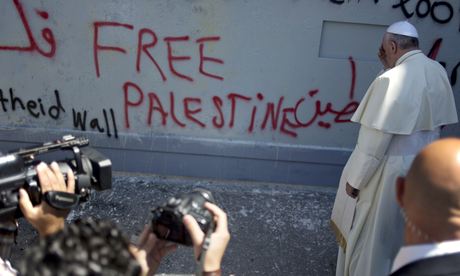
I am not surprised that there are such contradictory reactions to Pope Francis’ recent visit to Palestine and Israel. To begin with, there are sharply divergent views about the Catholic Church, and the papacy itself. Understandably for some, the complicity of the Catholic hierarchy with the shocking prevalence of sexual abuse by priests of young boys seems institutionally discrediting in the extreme.
The anti-modern cult of celibacy and a failure to allow women to participate equally in the life of the Catholic Church furthers undermine its moral authority given the changing realities of the 21st century.
Beyond this there are questions raised about Pope Francis’s own past, whether he was far too passive during the time of the ‘dirty war’ in Argentina, and too slow to favor the humane treatment of homosexuality. He has always chosen a simple life for himself, dedicating his pastoral efforts to benefit the poor, and being active as a leader in inter-faith activities.
Since becoming Pope these virtues have been the signatures of his leadership, earning him praise and love from around the world, and helping us understand why his acts of devotion have been so widely seen, and an inspirational alternative to what is passed off as ‘global leadership’ in Washington.
Unavoidably, his visit itself has been parsed in many ways and spun in all directions. Some insist that he should never have crossed the line separating religion and politics as he did when he made it clear he was visiting ‘the state of Palestine’ and not the ‘Occupied Palestinian Territories.’
Others complained that in such a situation of oppression and inequality, his carefully orchestrated efforts to acknowledge both sides equally actually gave rise to a false impression.
In this respect, it was not acceptable and politically misleading to pay homage at the grave of Theodore Herzl, the founder of Zionism, or to treat Shimon Peres as a man of peace. Still others fault the Pope for not calling attention to the plight of Gaza or the threats confronting Bedouin communities.
In my view, perhaps overstated, such carping misses the point, and manifests a disabling form of blindness. What was worth seeing, and only this, was the Pope bowed in prayer at the Bethlehem apartheid wall.
It was this electrifying image, and the related story about how young Palestinian boys dared defy Israeli soldiers by writing welcoming graffiti behind where the Pope stood that makes the visit an unforgettable, even if unintended, affirmation of the Palestinian struggle against multiple forms of injustice.

What will allow us to see better in the senses meant here is to appreciate why this image was and is so electrifying, will endure, and why the various commentaries, criticisms, and calumnies will soon to be forgotten.
What we need to realize, whether we like it or not, is that the Catholic Church by its sheer presence, persistence, and resilience occupies a distinctively deep place in the thinking and feeling of people throughout the world, including tens of millions of non-Catholics.
And the pope as the leader of Catholicism, in ritual and doctrine, enjoys a spiritual power of pronouncement without needing to utter a single word.
And when that power is used charismatically, as at the wall, no cascade of words can suffice to offset the impact of such a potent image and metaphor. The Israeli Prime Minister vainly informed the world that the wall was there to prevent suicide bombing and had contributed to Israeli security since its partial construction more than a decade ago.
It is equally irrelevant to refute this claim or to argue in opposition that the World Court had declared a wall built deep in Palestine amounted to an unlawful confiscation of land, imposing hardships, and should be dismantled and compensation paid for harm done.
The Pope is not a lawyer nor is it a time to engage the controversy about the security functions of the wall. What counts, and all that counts, is that the wall has become a devastating image and metaphor of injustice and oppression, with Israelis as the perpetrators and Palestinians as the victims.
Hany Abu-Assad’s fine film, Omar, a finalist for best foreign film at this year’s Academy Awards ceremony, also used the wall as the dominant wordless metaphor of what it meant for Palestinian lives to endure oppression day by day, showing its reality for all those with eyes that see.
Reacting to injustice is above all a visual and visceral experience. This is what Pope Francis has taught us. But first we must open our eyes, and keep them open. The greatest writers also perform their magic with language mostly by redirecting our line of vision.
Richard Falk is an international law and international relations scholar who taught at Princeton University for forty years. Since 2002 he has lived in Santa Barbara, California, and taught at the local campus of the University of California in Global and International Studies and since 2005 chaired the Board of the Nuclear Age Peace Foundation. http://richardfalk.wordpress.com
